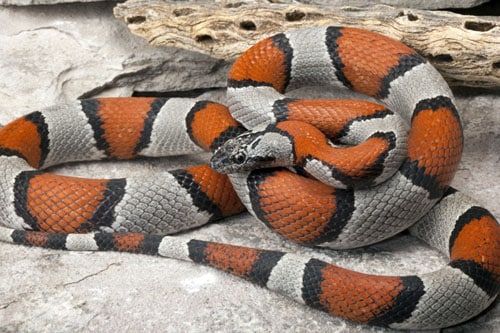Care Sheet for the Gray-Banded Kingsnake (Lampropeltis alterna).
Gray-Banded Kingsnake
The gray-banded kingsnake (Lampropeltis alterna) makes a marvelous pet. It does not attain a large size, is usually a good feeder on easily acquired food items, and it exhibits beautiful coloration. With a keeper who prioritizes reptile health and wellness, this species thrives in captivity!
Gray-banded kingsnakes are naturally found in west Texas, New Mexico and northern Mexico. They are denizens of rocky haunts found in the Chihuahuan Desert. Because of its intense variability, the gray-banded kingsnake is one of the most sought-after snakes found in the United States. Indeed, many people from all walks of life make a yearly journey to west Texas in the hopes of finding a gray-banded kingsnake.
Gray-banded kingsnakes have a docile demeanor and usually feed readily on domesticated mice. Because of this, adults of this species make wonderful captives for first time snake keepers. If you purchase a hatchling, make sure you acquire one that has fed on pink mice. Gray-banded kingsnakes come in a dazzlingly array of colors ranging from brilliant light gray and orange to darker morphs.
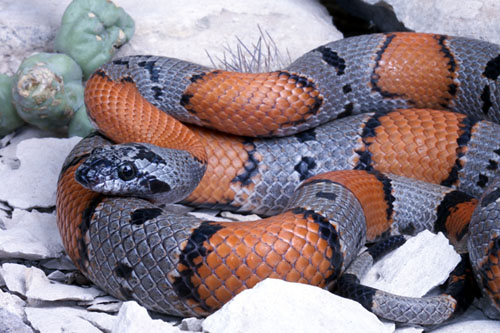
Photo Credit: Gerold Merker
Gray-banded kingsnakes originate from various localities, and from where may affect their price. This is a male Christmas Mountain gray-banded kingsnake.
Gray-Banded Kingsnake Availability
Gray-banded kingsnakes are readily available at reptile specialty stores, online reptile shops, and at many reptile shows and expos. They can sometimes be purchased for as little as $25, although gray-bands sold at that price are usually non-feeding babies. Prices can go up from there. You will likely discover, too, that locality-specific gray-banded kingsnakes cost more because a breeder has taken the time to breed snakes found at the same location. Some of these localities include Langtry, Highway 277, Christmas Mountains, and the River Road, to name a few.
Gray-Banded Kingsnake Size
Gray-banded kingsnakes range in length from 10 inches as hatchlings to adults that may be longer than 3 feet. The record length is 57 inches, although such behemoths are rarely seen, even in captivity. Most captive gray-banded kingsnakes range from 24 to 36 inches, and gray-bands of this size are perfectly suited for keeping in a 10- or 15-gallon terrarium.
Gray-Banded Kingsnake Life Span
Given the proper care, a gray-banded kingsnake can be a very long-lived pet. My family has one that has been in our care for more than 26 years, and when it was acquired, it was probably already several years old. I have no doubt that some gray-banded kingsnakes can live into their thirties.
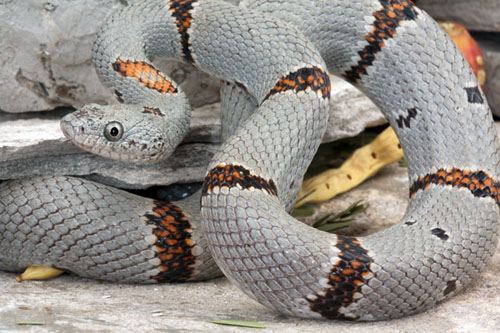
Photo Credit: Gerold Merker
Gray-banded kingsnakes usually average about 3 feet in length. An adult can be kept in an enclosure equivalent in size to a 10-gallon aquarium. This is a Hueco Mountains male.
Gray-Banded Kingsnake Enclosure
Simple caging works exceptionally well when maintaining gray-banded kingsnakes. Any enclosure must be escape-proof. All snakes are superior escape artists, and given even the slightest opening, most will take advantage and quickly disappear. Avoid this situation, especially if you have cats or dogs. There are many cages that are designed to prevent escape and it is wise to invest in one of these enclosures, so this is important to think about when purchasing snake supplies.
We kept gray-banded kingsnakes in 10-gallon reptile terrariums with secure tops for many years with excellent results. Such enclosures are easy to clean, and they are great for maintaining the proper temperatures for gray-banded kingsnakes. When our snake collection began to grow in size, we began utilizing a rack system. If you have many snakes, a rack system can be a space saver, and one can work very well when maintaining a colony of gray-banded kingsnakes.
Various snake substrates work well with gray-banded kingsnakes, including newspaper, paper towels, shavings (not too dusty, and never cedar), and CareFresh bedding. Of course, it is important to keep the cage clean. This may involve spot-cleaning at least twice weekly, and changing the entire substrate six or seven times a year. Dirty substrate can result in a build-up of bacteria, which could be harmful to your snake.
A solution comprised of 95 percent water and 5 percent bleach with a little liquid soap added makes an excellent cleanser. On the days you replace all the substrate, also rinse out the entire cage with this cleanser. As needed, also use it to clean out your snake’s water bowl and hiding place (cave, etc.). After using the cleanser, rinse everything clean with copious amounts of clean water to ensure all the cleanser is removed from the cage. Dry the cage, water bowl and hide, and the cage will be ready for new substrate — and your gray-banded kingsnake, of course! There are also cleaning kits available for the beginner enthusiast.
Most snakes, including gray-banded kingsnakes, are retiring and will appreciate an area in the cage where they can remain hidden from view. We provide two different hides: one in the warm region of the cage and one in the cooler region (read about temperature gradients below). This gives the snake a choice.
We also provide a damp area in the form of a plastic box, such as a Tupperware container, with a hole twice the diameter of the snake cut into the top or the side. Dampened paper towels are placed inside this container. It is useful to help maintain humidity, and especially if your gray-band is getting ready to shed its skin.
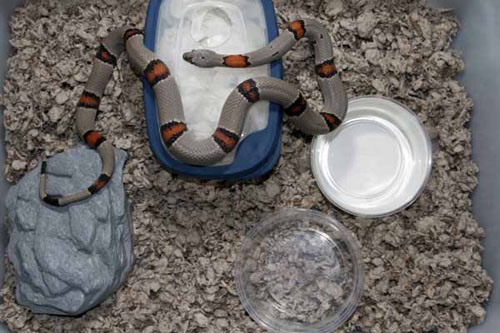
Photo Credit: Gerold Merker
An enclosure for a gray-banded kingsnake does not have to be complicated with snake habitat products. In this photo, note the plastic container with the hole cut in the top; it contains some moistened paper toweling to aid in providing humidity.
Gray-Banded Kingsnake Heating & Lighting
One of the most important considerations regarding the gray-banded kingsnake enclosure is the creation of a thermal gradient in the cage. Having one will allow your snake to choose where to position itself along a range of temperatures.
The easiest way to establish a gradient is by placing a heat tape or heat pad in a routed groove under one side of the cage. To ensure that the heat tape maintains a constant temperature, a good pulse-proportional thermostat is essential. Pulse-proportional thermostats maintain a constant temperature (+/- 1 degree Fahrenheit), thus preventing the cage bottom from becoming overly warm.
A temperature gradient of 65 degrees Fahrenheit at the cool end of the cage to 88 degrees at the warm end is a good starting point. Adjust the range if you notice your snake constantly moving about the cage; this may mean it cannot find a comfortable temperature. These warmer temperatures can be maintained during spring, summer and fall.
A good strategy for maintaining the general health of a gray-banded kingsnake is to allow it to cool down for a few months during winter (brumation). Doing so simulates what the snake would experience in its native habitat. Maintain your snake at the usual warmer temperatures for 14 days prior to the winter cooling, but stop feeding it during this time in order to clear its stomach and intestines. Because cool temperatures inhibit digestion, failure to do this may result in a hazardous situation: undigested food sitting in your snake’s gastrointestinal tract, which can kill your snake. After the 14 days, clean the enclosure and add fresh substrate, then turn off the heat tape and allow the cage to cool to about 55 degrees. Check your snake at least weekly and provide it with fresh water.
A winter cool-down can also help tremendously in stimulating a gray-banded kingsnake’s feeding response the following spring. Reluctant feeders, including hatchlings, often emerge from brumation with an intense feeding response.
Gray-Banded Kingsnake Food
Gray-banded kingsnakes will usually accept live reptile food, such as feeder mice, but as hatchlings, they may require a few lizards to get them started. Once they start taking appropriately sized mice, they will feed on these for the rest of their captive lives. An appropriately sized mouse ranges from a pink mouse for a hatchling snake, a fuzzy for a juvenile, and a small adult mouse for an adult gray-banded kingsnake.
Some gray-banded kingsnakes will not readily accept mice, and a couple “tricks” can be employed to entice a stubborn gray-band to do so. The easiest is to gently “wash” a frozen/thawed mouse with a live lizard, such as a common anole. Rubbing the lizard’s cloacal region or its throat on the mouse works well for scenting the mouse. Place your gray-band in a small enclosure with the scented mouse, and usually the snake can be enticed to feed upon it. You may need to jiggle the mouse a bit using 12-inch forceps, and this may take several tries before the snake accepts the mouse.
Another trick is to brumate your snake at 50 to 60 degrees for a month or so. If you do this, follow the instructions given previously regarding the cessation of feeding attempts prior to the cooling. After a month at the cooler temperatures, slowly raise them back to normal. Often, the snake will feed on a pink mouse after being warmed back up.
Feed your gray-banded kingsnake two to four times monthly during spring, summer, and fall (as mentioned, do not feed during the winter cool down). It is prudent not to handle your gray-banded kingsnake too soon after it has eaten, otherwise it may regurgitate its meal.
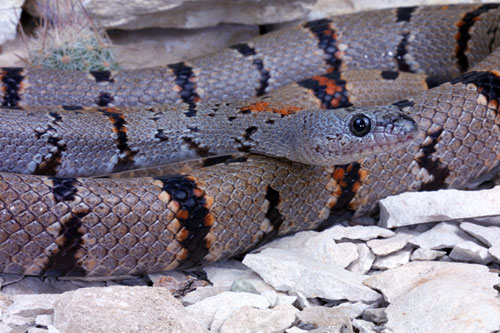
Photo Credit: Gerold Merker
Mice are the typical diet for pet gray-banded kingsnakes.
Gray-Banded Kingsnake Handling and Temperament
Gray-banded kingsnakes will usually allow gentle handling with no problem. If your snake has a strong feeding response, however, to prevent it from mistaking your hand for food, before reaching into its enclosure gently nudge the snake with an inanimate object (such as forceps). This lets the snake know it is not feeding time.
When holding a gray-banded kingsnake, let it slither about in your hands in an unrestrained manner. Don’t grip it too tightly. If you try and restrain the snake too forcefully, you may get a gentle nip or the snake may release musk to demonstrate its displeasure. Always support your snake with both hands so it does not feel threatened.
Finally, never use your pet gray-banded kingsnake to scare a person who is not a fan of snakes. That person would then be less likely to be enamored with snakes in the future, and snakes need all the fans they can get, after all!
Gerold Merker and his wife Cindy maintain a large group of gray-banded kingsnakes which they have been breeding for the past 33 years. He has published numerous articles on the species, and co-authored a book, Alterna: The Gray-banded Kingsnake, which details their natural history. geroldandcindymerkerreptiles.com.

